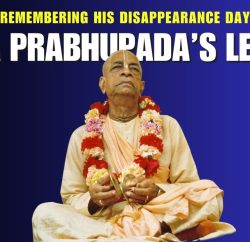Narahari Sarakāra Thakura was a prominent devotee in the 16th-century Gaudiya Vaishnava tradition, a close associate and disciple of Sri Chaitanya Mahaprabhu and Sri Nityananda Prabhu.
Among the most cherished associates who helped distribute the unprecedented outpouring of pure love of Godhead was this poet, singer, and spiritual giant from the village of Srikhaṇḍa in Bengal.
Table of Contents
A Flourishing Branch of the Chaitanya Tree
The significance of Narahari Sarakāra and his family is clearly established in the historical biography, Sri Chaitanya-Charitamrita. Sri Krishnadasa Kaviraja Goswami writes that the residents of Srikhaṇḍa formed a “powerful branch of the desire tree of love of Godhead”.
Sri Chaitanya-Charitamrita (Adi-lila 10.78–79) affirms:
“Sri Khaṇḍavāsī (the residents of Sri Khaṇḍa) Mukunda and his son Raghunandana were the thirty-ninth branch of the tree, Narahari was the fortieth, Chiranjiva the forty-first, and Sulocana the forty-second. They were all big branches of the all-merciful tree of Chaitanya Mahaprabhu. They distributed the fruits and flowers of love of Godhead anywhere and everywhere.”
Narahari Thakura stood out as an exalted Vaishnava, celebrated for his deep devotion, poetic genius, and musical talent, which he dedicated entirely to the glorification of the Lord.
Poet, Guru, and Glorifier of Gaura
Narahari Sarakāra’s contributions extended beyond personal service to the development of Vaishnava literature and tradition:
- Poetic Genius: He was a renowned singer and composer whose works are celebrated for their profound spiritual emotion. He was celebrated for his “poetic genius and musical talent.”
- Spiritual Master: His most famous disciple was Locana Dasa Thakura, the celebrated author of Sri Chaitanya-maṅgala
- Intimate Service: Narahari was known for the intimate service he performed for the Lord, such as fanning Him with a cāmara. This is immortalised by Srila Bhaktivinoda Thakura in the famous Gaura-ārati bhajan:
“Narahari ādi kare cāmara dhulāy, Sañjaya, Mukunda, Vasu Ghoṣa ādi gāy”
(“Narahari and the other residents of Srikhaṇḍa fanned the Lord with the cāmara [yak-tail fan], while Sañjaya, Mukunda, and Vasu Ghoṣa sang melodious kīrtans.”)
The Unified Devotional Family of Srikhaṇḍa
The devotional atmosphere of Srikhaṇḍa was fostered by an entire family unit committed to pure service. The family lineage included:
- Elder Brother: Nārāyaṇa Dasa (father of Mukunda Dasa).
- Sri Narahari Sarakāra Thakura.
- Younger Brother: Mādhava Dasa (father of Raghunandana Dasa).
This dedication continued through generations, with Raghunandana Dasa’s son, Kanai, who had two sons: Madana Raya (a disciple of Narahari Thakura) and Vamshivadana, solidifying Srikhaṇḍa as a pillar of the movement.
The Verdict on Harmonious Service
The most instructive lesson from the Srikhaṇḍa devotees lies in how Sri Chaitanya Mahaprabhu personally assigned them distinct, yet equally important, duties, demonstrating the unity of purpose in devotional service:
| Devotee | Entrusted Duty | Principle of Service |
| Mukunda | To earn money and follow religious principles. | Supporting the Mission through honest work. |
| Narahari | To remain in the association of devotees. | Spreading Consciousness through satsaṅga. |
| Raghunandana | To serve the Lord in the temple. | Worship of the Deity (arcana). |
Though these activities may appear different externally, they are one in essence. The timeless verdict of Chaitanya Mahaprabhu is that when the Lord (Krishna or Gauranga) is the centre, every activity, regardless of its external form, transforms into pure devotional service.
Narahari Sarakāra Thakura and his lineage show us that devotion is not restricted to a single type of activity but can infuse every aspect of life, making the entire world a field for loving service to the Divine.










